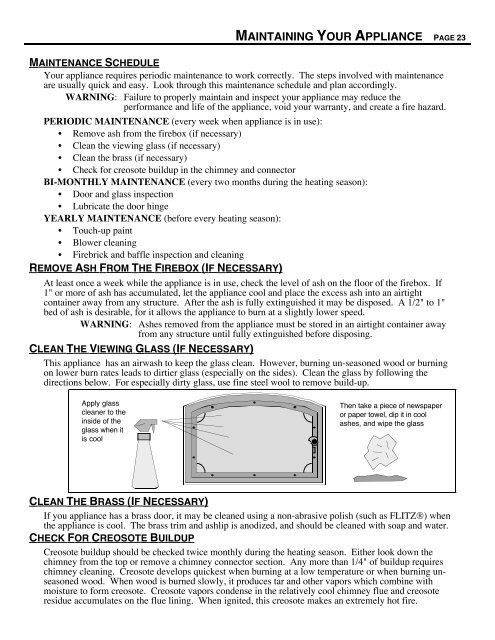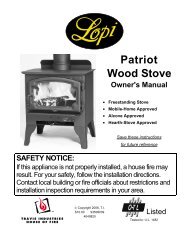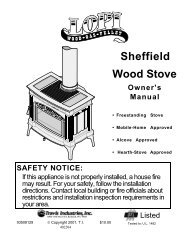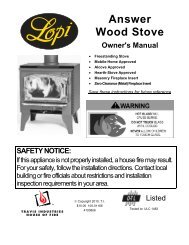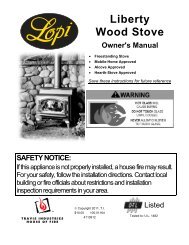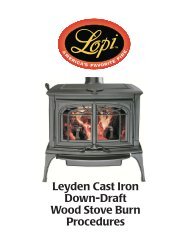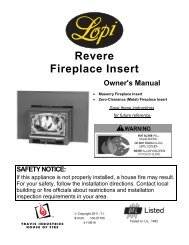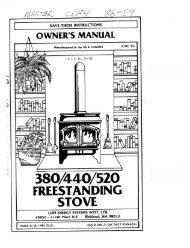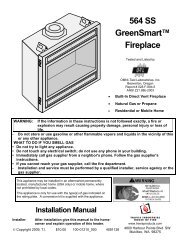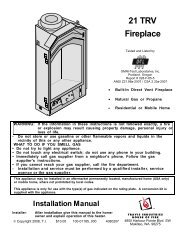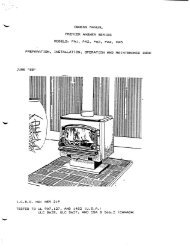¥ Endeavor (380) Manual - Lopi
¥ Endeavor (380) Manual - Lopi
¥ Endeavor (380) Manual - Lopi
Create successful ePaper yourself
Turn your PDF publications into a flip-book with our unique Google optimized e-Paper software.
MAINTAINING YOUR APPLIANCE PAGE 23<br />
MAINTENANCE SCHEDULE<br />
Your appliance requires periodic maintenance to work correctly. The steps involved with maintenance<br />
are usually quick and easy. Look through this maintenance schedule and plan accordingly.<br />
WARNING: Failure to properly maintain and inspect your appliance may reduce the<br />
performance and life of the appliance, void your warranty, and create a fire hazard.<br />
PERIODIC MAINTENANCE (every week when appliance is in use):<br />
<strong>¥</strong> Remove ash from the firebox (if necessary)<br />
<strong>¥</strong> Clean the viewing glass (if necessary)<br />
<strong>¥</strong> Clean the brass (if necessary)<br />
<strong>¥</strong> Check for creosote buildup in the chimney and connector<br />
BI-MONTHLY MAINTENANCE (every two months during the heating season):<br />
<strong>¥</strong> Door and glass inspection<br />
<strong>¥</strong> Lubricate the door hinge<br />
YEARLY MAINTENANCE (before every heating season):<br />
<strong>¥</strong> Touch-up paint<br />
<strong>¥</strong> Blower cleaning<br />
<strong>¥</strong> Firebrick and baffle inspection and cleaning<br />
REMOVE ASH FROM THE FIREBOX (IF NECESSARY)<br />
At least once a week while the appliance is in use, check the level of ash on the floor of the firebox. If<br />
1" or more of ash has accumulated, let the appliance cool and place the excess ash into an airtight<br />
container away from any structure. After the ash is fully extinguished it may be disposed. A 1/2" to 1"<br />
bed of ash is desirable, for it allows the appliance to burn at a slightly lower speed.<br />
WARNING: Ashes removed from the appliance must be stored in an airtight container away<br />
from any structure until fully extinguished before disposing.<br />
CLEAN THE VIEWING GLASS (IF NECESSARY)<br />
This appliance has an airwash to keep the glass clean. However, burning un-seasoned wood or burning<br />
on lower burn rates leads to dirtier glass (especially on the sides). Clean the glass by following the<br />
directions below. For especially dirty glass, use fine steel wool to remove build-up.<br />
Apply glass<br />
cleaner to the<br />
inside of the<br />
glass when it<br />
is cool<br />
Then take a piece of newspaper<br />
or paper towel, dip it in cool<br />
ashes, and wipe the glass<br />
CLEAN THE BRASS (IF NECESSARY)<br />
If you appliance has a brass door, it may be cleaned using a non-abrasive polish (such as FLITZ®) when<br />
the appliance is cool. The brass trim and ashlip is anodized, and should be cleaned with soap and water.<br />
CHECK FOR CREOSOTE BUILDUP<br />
Creosote buildup should be checked twice monthly during the heating season. Either look down the<br />
chimney from the top or remove a chimney connector section. Any more than 1/4" of buildup requires<br />
chimney cleaning. Creosote develops quickest when burning at a low temperature or when burning unseasoned<br />
wood. When wood is burned slowly, it produces tar and other vapors which combine with<br />
moisture to form creosote. Creosote vapors condense in the relatively cool chimney flue and creosote<br />
residue accumulates on the flue lining. When ignited, this creosote makes an extremely hot fire.


